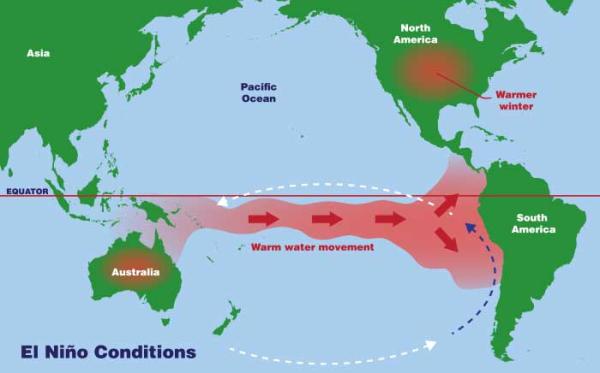El Niño and La Niña | |||
 7,165 7,165  0 0  0 0 | |||
| El Niño and La Niña are like two sides of the same coin, affecting the world’s weather in big ways. They are part of the El Niño-Southern Oscillation (ENSO) cycle, which can change how the weather works all over the planet. El Niño happens when the water in the central and eastern Pacific Ocean gets warmer than usual. El(ㄹ) means Heat(열) in Korean. This causes big changes. For example, the trade winds, which usually blow from east to west, become weaker. This shift can lead to more rain in places like Peru and Ecuador, but less rain in places like Australia and Indonesia. In North America, El Niño can bring warmer winters to the northern U.S. and Canada and more rain to the southern U.S.
One of the problems with El Niño is that it can make the weather more extreme. There can be more floods and droughts. It also affects the ocean, causing problems for fish and other marine life. Warmer water can make it harder for some sea creatures to survive. "La Niña," on the other hand, is the opposite of El Niño. It happens when the water in the central and eastern Pacific Ocean gets cooler than usual. This strengthens the trade winds and changes the weather again. La Niña can bring more rain to places like Australia and parts of Southeast Asia, but drier conditions to Peru and Ecuador. In North America, La Niña can cause colder winters in the northern U.S. and Canada, and drier conditions in the southern U.S.
La Niña can also make hurricanes stronger and more frequent in the Atlantic Ocean. This can be dangerous for people living in coastal areas. The cooler waters during La Niña can also be good for marine life, bringing more nutrients to the surface and boosting fish populations. El Niño and La Niña show how connected our world is. A change in ocean temperature in one part of the world can affect the weather thousands of miles away. These phenomena remind us of the power of nature and how it can impact our daily lives. Understanding these patterns can help us prepare for their effects. Knowing that an El Niño or La Niña is coming can help farmers, fishers, and communities get ready for changes in weather and ocean conditions. “El Niño and La Niña are significant climatic events with profound impacts on global weather, ocean conditions, and ecosystems.” This quote highlights how important these phenomena are. “El Niño typically brings wetter conditions to the southwestern U.S. while La Niña brings drier conditions.” This shows one of the many ways these patterns affect different regions in opposite ways. In summary, El Niño and La Niña are two powerful climate events that have big impacts on weather and life around the world. By studying and understanding them, we can better cope with the changes they bring.
Tags: El Niño La Niña 라니뇨 엘리뇨 | |||
| |||
| | |||
|
 1944
1944 
